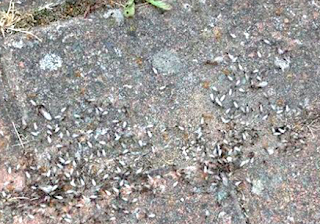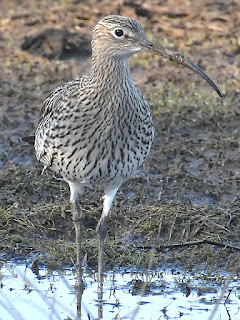 It’s difficult to say exactly how many pairs of Dartford warblers
breed on the peninsula - before last winter’s cold weather it could have been
up to 20. There are probably fewer pairs this year, but the good spring weather this
year may have ensured that these have done well. They breed mostly in the
extensive gorse on the cliffs along the south coast, but are slowly taking to
the commons. The gorse has to be just the right age to attract them, and about four
to five feet high seems to be best. It takes time to find them, and I sit for
quite a while before there are any signs. I usually hear them first. They sound
a bit scratchy, rather like whitethroats, but the call is distinct. Seeing them
is not so easy, but there’s a family party in the gorse below me, and I get
reasonable views as they skulk and flit quickly through the vegetation. They
often associate with stonechats, which is sometimes a good way of finding them,
but unlike stonechats they rarely perch on the tops of gorse, and getting a good view is
always a bit of a lottery.
It’s difficult to say exactly how many pairs of Dartford warblers
breed on the peninsula - before last winter’s cold weather it could have been
up to 20. There are probably fewer pairs this year, but the good spring weather this
year may have ensured that these have done well. They breed mostly in the
extensive gorse on the cliffs along the south coast, but are slowly taking to
the commons. The gorse has to be just the right age to attract them, and about four
to five feet high seems to be best. It takes time to find them, and I sit for
quite a while before there are any signs. I usually hear them first. They sound
a bit scratchy, rather like whitethroats, but the call is distinct. Seeing them
is not so easy, but there’s a family party in the gorse below me, and I get
reasonable views as they skulk and flit quickly through the vegetation. They
often associate with stonechats, which is sometimes a good way of finding them,
but unlike stonechats they rarely perch on the tops of gorse, and getting a good view is
always a bit of a lottery.
Typically a bird of warmer parts of Western Europe, the
Dartford warbler is one of the winners of climate change. In the 1960s they
were restricted to very small populations on the south coast of England, and
severe winters reduced the number of pairs in 1963 to just 11. Since then
they’ve spread throughout southern England, and are now well established on the
south coast of Wales, with the British population now estimated to be in the
thousands.

















